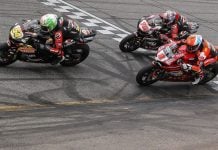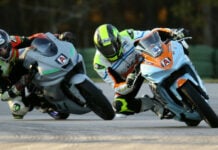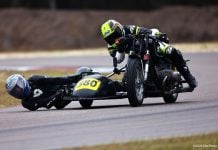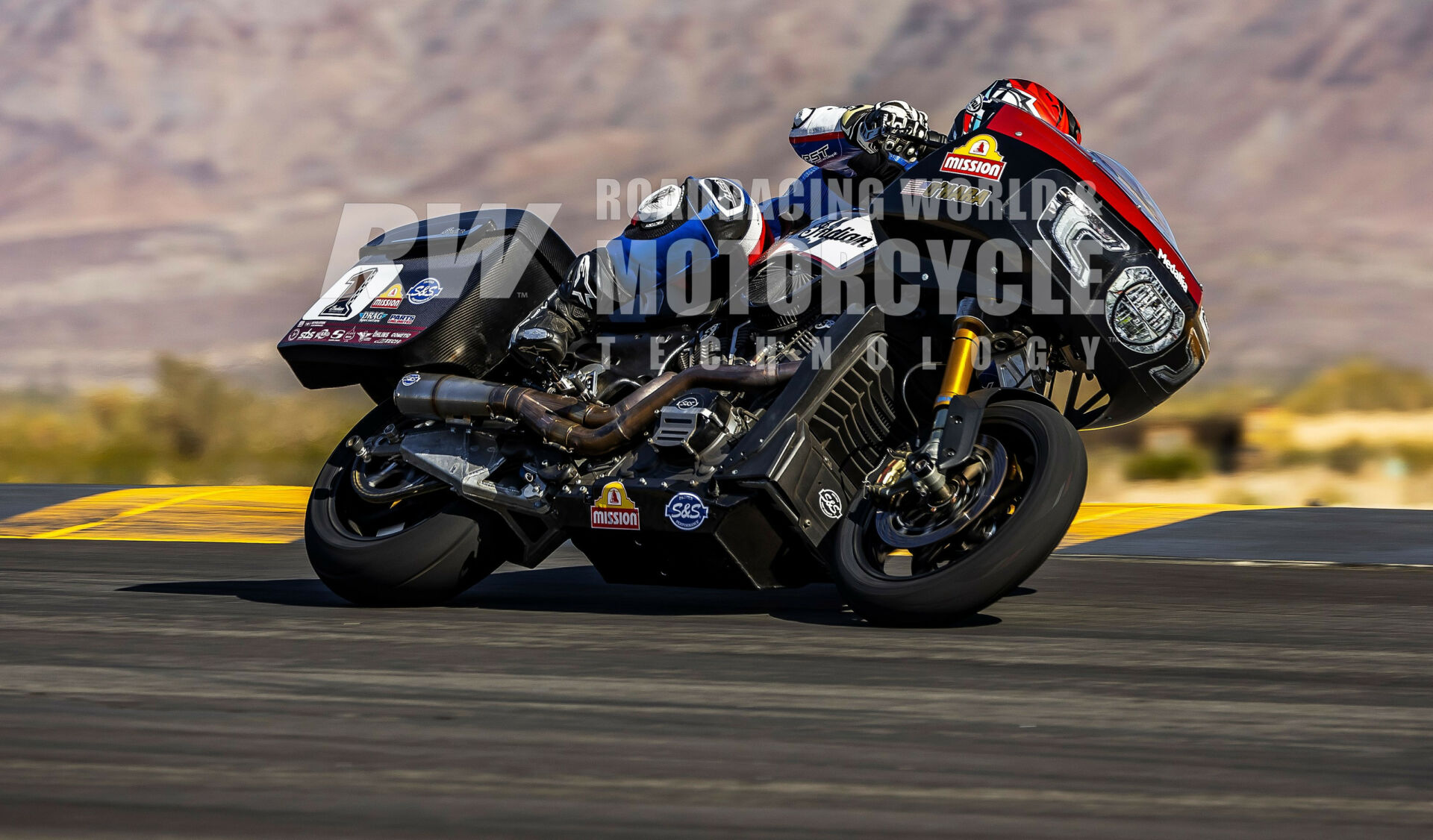Editorial Note: This article is the cover story in the March 2023 issue of Roadracing World & Motorcycle Technology magazine, which is on newsstands and available in its digital format now.
MOTOAMERICA RACEBIKE TEST
TYLER O’HARA’S INDIAN CHALLENGER BAGGER
HEAVY INTENSITY!
By Chris Ulrich
It took less than two seasons for Bagger racing to go from an exhibition to full-factory-racing insanity. That madness is being fueled by a fierce rivalry between Harley-Davidson and Indian that started generations ago, lay dormant for decades, and has been reborn, first in dirt track and now spilling onto the paved road courses of the MotoAmerica Superbike Series in a big way. In this case, “fierce rivalry” isn’t really strong enough to describe what has turned into an all-out battle for dominance in the Mission Foods King Of The Baggers and the RSD Super Hooligan National Championships, and things are only going to get more intense now that the Harley-Davidson Pan America model has been allowed in the Super Hooligan Series.
The war has powered development leading to a seven-second lap time improvement from the first Bagger exhibition race at Laguna Seca in 2020 to Laguna Seca in 2022. Some of the improvement came from switching to Dunlop slick tires, but most of it came from technical development. The fastest lap from the 2021 KOTB race at Laguna was a 1:31.9 set by Kyle Wyman on a Harley-Davidson. Wyman improved another 2.5 seconds in 2022, turning a 1:29.4 during the 2022 race. Imagine turning a sub-1:30 lap time around Laguna Seca on a Bagger! These bikes are legitimate weapons and the guys are riding them hard. It’s great to watch. And it’s only going to get better with both factories fully involved.
Rivalry aside, Indian is using racing to reinforce its high-performance credentials in the marketplace. In 2017, Indian launched the FTR, a dirt-track-inspired 1,200cc streetbike, and used AFT Flat Track racing to promote the new motorcycle. Indian also launched various promotions, including hiring Travis Pastrana to recreate Evil Knievel’s big jumps. And the inception of Roland Sands’ Super Hooligan Racing Series was spawned from Indian’s effort to be relevant in a space that was historically dominated by Harley-Davidson. Since all this started Indian and racing contractor S&S have won six AFT Championships, essentially making the factory Harley-Davidson effort non-competitive. More recently, in 2023, Indian won the AFT SuperTwins Championship with Jared Mees along with the MotoAmerica KOTB and SHNC Championships with Tyler O’Hara. All that success on the racetrack has turned a once-defunct brand Polaris, purchased and revived in 2011, to the marketplace powerhouse in 12 years. And just like that, owning an Indian is cool again.
I’ve written it before, but it’s worth repeating: Win on Sunday, Sell on Monday is still alive and well. Otherwise, these two big American companies would not be spending money on racing and working hard to use racing success to market motorcycles.
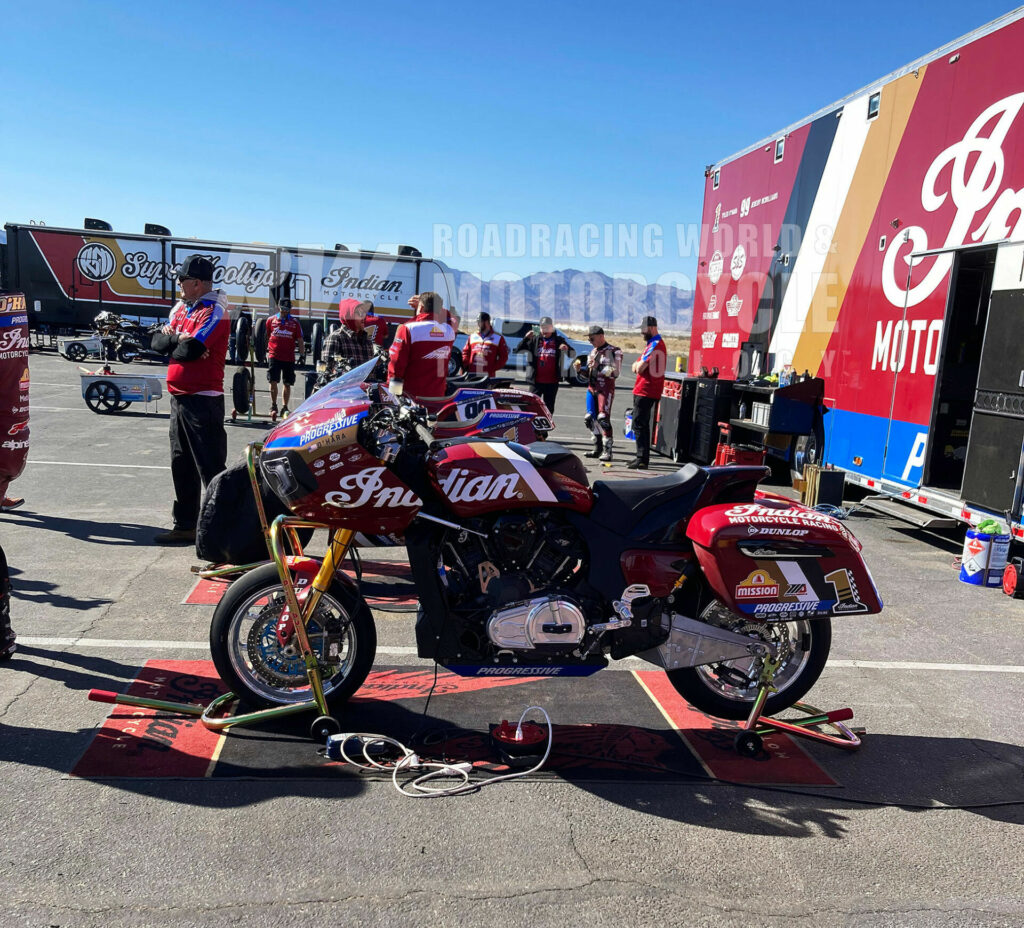
Direct factory involvement from Indian and Harley in the KOTB series has created additional well-paid jobs in the paddock, with some rider salaries matching the per-race amount paid by Superbike teams. Factory bonus programs for KOTB are also well above even the factory Yamaha bonuses, while posted contingency matches what is available from most sportbike manufacturers in other classes. The global effect the KOTB series has had on the paddock is also positive; the class has brought in a new demographic of fans, who spend their money on tickets and merchandise and, in a lot of cases, have become fans of Superbike and Supersport classes after being exposed to the racing. They come for the Baggers, and stay for the Superbikes. Love them or hate them, the economics of Bagger racing are good for professional motorcycle racing in the United States. And it’s damn entertaining to watch.
Indian representatives tout their racing activities as being a David vs. Goliath situation with H-D shipping six-times more motorcycles than Indian per year. But the racing programs are more similar than they think, at least in 2022. Most of the Indian and S&S crew members also must perform their regular day job duties on top of at-track racing activities, and the situation is the same for the H-D staffers on the Screamin’ Eagle program. And like Harley-Davidson’s team, the Indian team is passionate about racing, winning, and mainly beating the other guys!
The path to the 2022 King Of The Baggers Championship for Tyler O’Hara was not easy, but of the front-runners, he was the most consistent during the seven-round series. The season started well for O’Hara with a win in the opening race at Daytona, followed up with a second-place finish in Race 2. He stayed consistent for the remaining rounds, never finishing worse than fourth, and finally clinching the Championship in the rain-soaked finale at New Jersey Motorsports Park. In total, Indian riders O’Hara, Jeremy McWilliams, and Bobby Fong won three points-paying races during the 2022 season. The Indian crew also limited costly mistakes like those made by the Harley-Davidson team, the worst example being oiling the racetrack twice due to mechanical problems and getting Kyle Wyman disqualified at Brainerd.
Baggers are extreme bikes with extreme dimensions and the Indian is no exception. From the outside, the S&S Indian Challenger build looks to be more practical than the Harley-Davidson package. It could also be that the base design needs less modification to bring it up to race spec.
Indian relies on S&S to build its factory Indian Challenger racebike, which weighs roughly 630 pounds before adding fuel. It has a 65.5-inch (1,663mm) wheelbase, 23.5 degrees of rake, and 114mm (4.5 inches) of trail, making the Challenger’s chassis dimensions close to the Harley-Davidson Road Glide’s numbers. Per MotoAmerica KOTB rules, the main frame, the OEM front fairing shape, and the core engine must be retained. No external bracing can be added to the aluminum-alloy, backbone-design frame, but the rest of the chassis components can be replaced or modified.
As is the case with all Baggers, gaining cornering ground clearance is one the biggest challenges builders face. On the Indian, S&S modified the left-side engine cover, moving the clutch actuation arm from the bottom to the top of the case cover and adding a taper. A host of other S&S parts were used to bring the Challenger up to race spec. The stock triple clamps are replaced with adjustable aluminum triple clamps, with revised offset.
To get the front ride height needed to gain cornering clearance, the standard front forks were replaced by long-travel Öhlins FG8603 model forks that are original fitment on a Ducati Multistrada. Rear suspension is handled by an Öhlins TTX36 single shock. S&S also designed and built the rear-set controls, clip-on handlebars, front fairing bracket, axles, and rear brake hanger, which carries a thumb-operated dual-piston Hayes brake caliper. Dual 320mm (12.6-inch) rotors combined with four-piston Brembo calipers with 100mm spacing and a combination of 32mm/36mm pistons handle the braking duties at the front.
The final drive system for the Indian PowerPlus engine is located on the right side. For racing, S&S converted the OEM belt drive to chain drive, which required the addition of a chain tensioner due to the location of the countershaft sprocket relative to the swingarm pivot position. Bracing has been welded to the underside of the standard cast-aluminum swingarm. As ridden, the rear axle was pushed forward, putting the effective swingarm length at around 20-inches (508mm), which is very short compared to most modern sportbikes. Overall wheelbase is 65.5 inches (1,663mm), which is long compared to current sportbikes. The 2022-spec racebike used OZ aluminum wheels at the end of the season. For 2023 the team is going with specially-built PVM wheels to help eliminate wheel flex caused by the massive weight of the Bagger.
O’Hara’s Challenger is powered by Indian’s liquid-cooled 60-degree V-Twin PowerPlus engine. S&S Cycle had to push the limit of the 112 cubic-inch (1,833.3cc) PowerPlus engine to match the power output of the H-D Milwaukee-Eight’s 131 cubic-inch (2,152cc) engine. In doing so, the lifespan of the engine dropped to one race weekend: The S&S and Indian team had to swap engines mid-weekend at every event to avoid issues. Do the math, and that’s 14 engines for two riders over a seven-race series, not including testing. (The new 7,700 rpm rev limit imposed by MotoAmerica for 2023 should help durability. S&S reps say the rev limit was higher in 2022, but the bike we tested had the new limit implemented.)
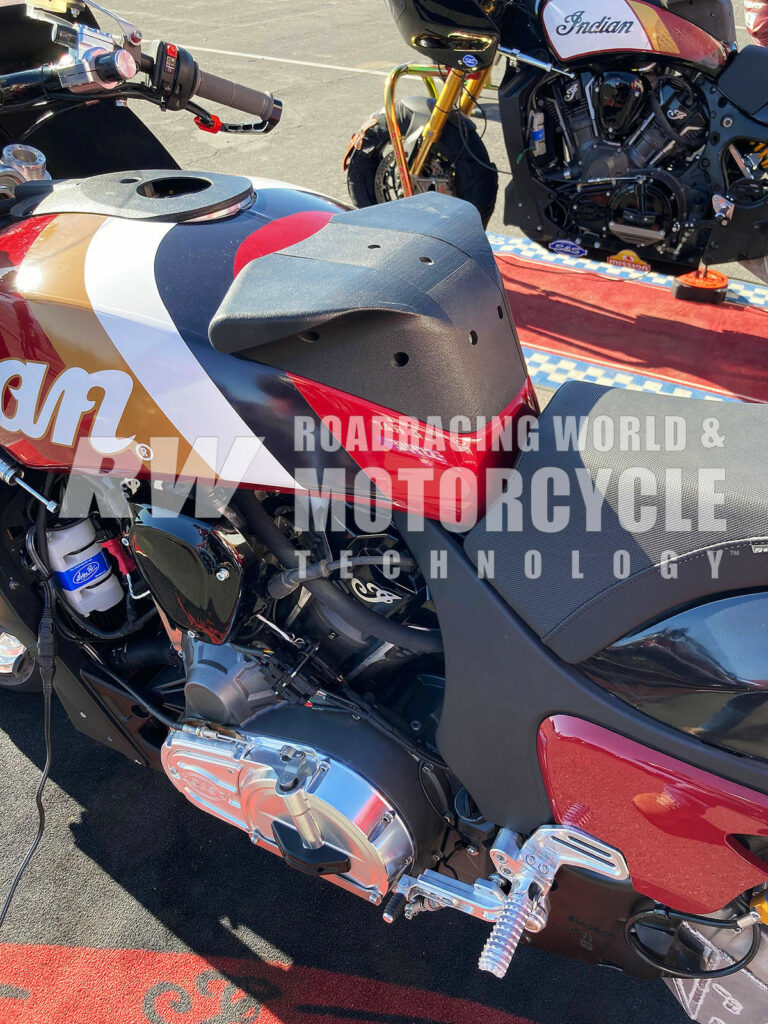
There is no replacement for displacement, which is why the PowerPlus engine’s bore was increased 2mm from 108mm to 110mm, bringing the displacement up to that 112 cubic inches. Stock pistons were replaced with 2mm oversize CP units. Additional performance increases came from custom-ground S&S camshafts and CNC-ported heads. The stock rockers were replaced with billet units manufactured by S&S. The main bearings were also pinned in place for improved durability.
The standard dual, 52mm ride-by-wire throttle bodies were located where a frame rail restricted air flow to the engine, so they were replaced with a relocated, 78mm single throttle body made for a car, and it came from a V6 Dodge Charger. S&S designed and 3D-printed a new intake manifold and runner to fit the throttle body. Spent gasses flow out from the exhaust ports into an S&S-built stainless steel exhaust system.
Electronics are limited, but Indian gained an allowance from MotoAmerica to run a MaxxECU Sport unit. The Maxx brand is better known for car applications than motorcycle use, but is fine in this case given the fact that no rider aids are allowed in the KOTB class. The racing-spec Indian Challenger comes with a quick-shifter and auto-blip function. An AIM DL2 data logging display replaces the stock dash.
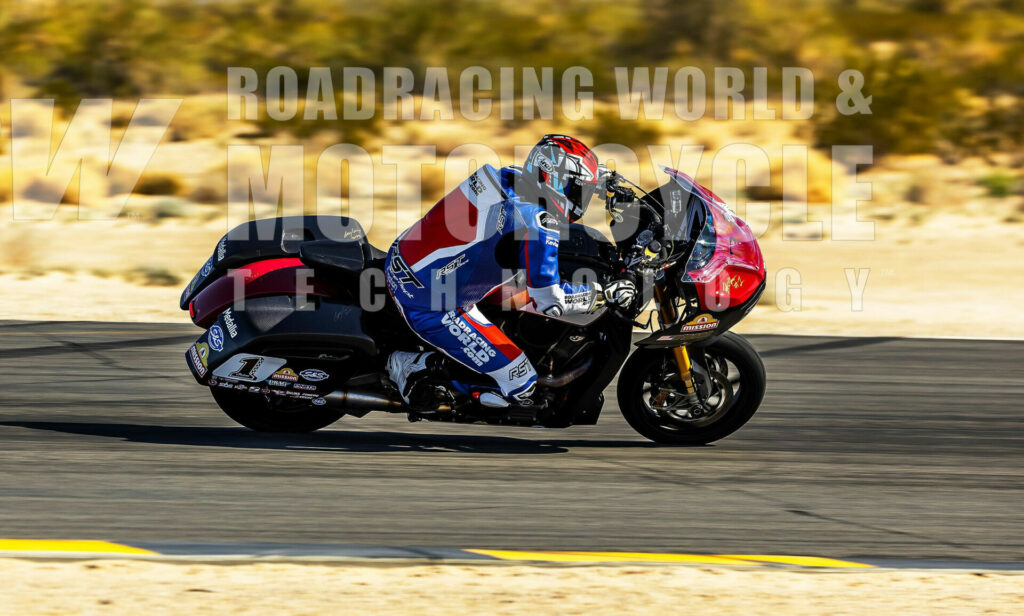
Riding Tyler O’Hara’s Indian Challenger
I was standing in the pits buzzing from an adrenaline spike after my five laps around Chuckwalla Valley Raceway on Tyler O’Hara’s Bagger. My opening lap was awkward, but my second lap was better. I was getting comfortable on the bike by lap three, lap four was faster, and I improved three more seconds on lap five, then ignored the checkered flag to finish the lap I was on. The lap timer went 2:08, 2:05, 2:05 (in traffic), 2:03, and at the end I turned a 2:00.9. Which frankly isn’t impressive at all, but considering my lack of experience and time available on what is a very unique motorcycle I was fine with it.
What surprised me was the level of concentration it took to get to that point—and how wound up I was getting off the bike! The Challenger was exciting and I wanted another go at it. I haven’t felt that way about a motorcycle since I stopped racing Superbikes in 2016!
The ergonomics on the Challenger felt more natural to me than they did on Kyle Wyman’s Harley-Davidson when I rode it at Inde Motorsports Park for the March 2022 cover story. The reach and angle of the bars feel more like a sportbike’s. The seat -to-peg distance is relaxed and the overall height is shorter, so it was easier to get my feet on the ground. And it felt more natural to ride since it wasn’t so high.
The intensity comes partially from the unknown and learning how to ride a bike that is unique to the category. But the rest comes from the massive amount of chassis-generated movement on both ends of the motorcycle. The Challenger starts to move during braking while still straight up and down. The forks compress quickly, which causes the bike to wallow before turning in. And the relatively steep steering angle made it feel like I was over the top of the front end. However, the long wheelbase helped mitigate the forces. It doesn’t take an excessive amount of effort to roll the Indian into the corner, likely because it has a high center of gravity. But the movement really never stops.
At the apex, the front wheel feels like it’s under the bike and the tire is trying to fold (tuck) but again, a relatively high trail number and long wheelbase saves the day. I definitely tried to get off the brakes and back on the gas as early as possible. Usually, a bike would lack feel in this situation, but Challenger gave plenty of feedback at full lean.
The Challenger’s handling on corner exit is unique. The first thing I noticed was a lack of rigidity at the center of the motorcycle. This is no doubt caused by turning a bike that started life as a huge streetbike into a racebike. The main frame definitely isn’t designed for racing. That’s a fact of life, but the movement is not all bad as it provides plenty of feedback. Flex is part of the game with Baggers.
However, the Challenger does behave differently at corner exit depending on the direction you’re turning. When I was in a right turn, the rear would move, then the chain tensioner would take out slack and cause the rear to slide. The step-out-and-slide reaction would change depending on the throttle position and amount of lean angle. But it was consistent: Add throttle, change chain slack, step out, slide, repeat. Once stood up, the bike would start to behave normally.
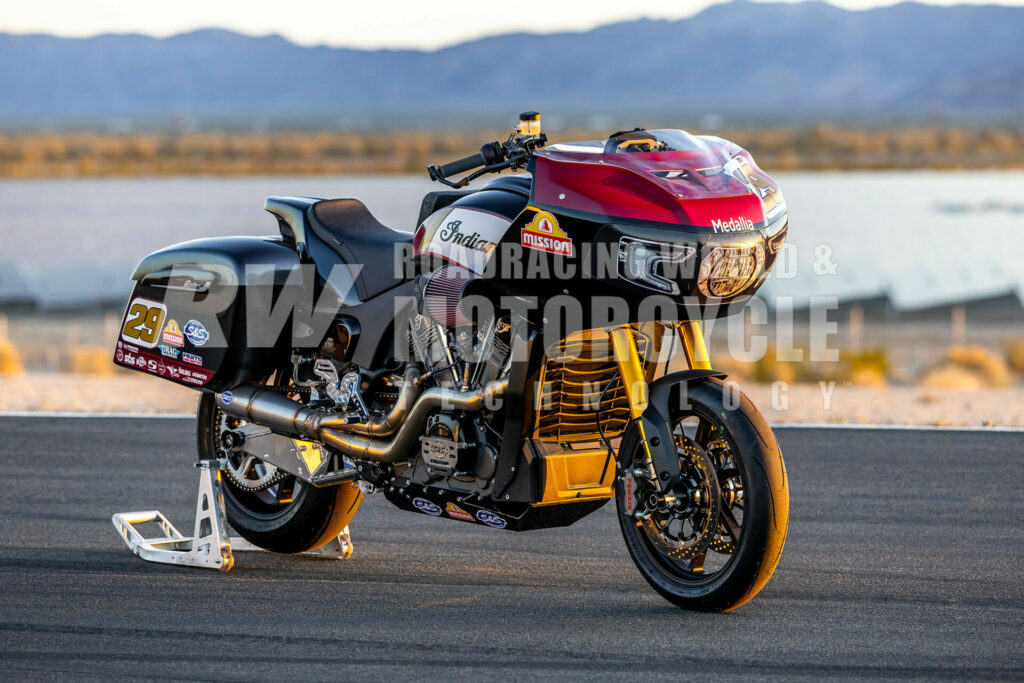
Going left, the bike was easier to turn in and get to the apex and behaved more normally on corner exit. I could crack the throttle, set it, then roll it on and the rear would dig in and then drive forward normally. The bike did have a tendency to stand up too early on the lefts. This behavior was so strange! I think it comes down to the manual chain tensioner on the right-side drive needed more development. Probably a spring change to make the action more consistent.
While the chassis is different, the engine is great. It produces smooth, tractable power from 3,000 rpm to 7,700 rpm. The rev limiter comes on pretty quickly in some situations, so I suspect the team has to compromise on gearing at some tracks. The transmission performance is very good on the Indian. The throw between gears is short, so I didn’t have to worry about being deliberate with my downshifts. And having a quick-shifter was really nice. I tried the auto-blip on an early lap but wasn’t impressed, so I ended up going old-school and manually down-shifting.
How does it compare to the Harley-Davidson? I’ve only ridden one other Bagger on the racetrack, that being Kyle Wyman’s 2021 King Of The Bagger Championship-winning Harley-Davidson Road Glide. So, my frame of reference is small, but there are very distinct differences in the fundamental chassis design of the bikes that make the Indian more natural and enjoyable to ride. For example, the overall height on the Harley-Davidson makes it unwieldy, but it doesn’t pitch so it remains stable. The Harley-Davidson’s stepped triple-clamp design puts the front wheel pretty far out from the rider, so while it sticks, it lacks connection and feel. And the Harley-Davidson Milwaukee-Eight 131 transmission is pretty bad. The mental energy required for those guys to not miss shifts is probably worth half-a-second a lap. A quick-shifter would be nice, too. But in the end the Harley-Davidson and the Indian turn similar lap times, so it’s obvious there is more than one way to do things.
Having ridden both bikes, if I was pressed to choose between them I’d pick the Indian as it just feels more natural to me.
I was still buzzing for hours after my five laps around Chuckwalla on the Indian Challenger. The Baggers are impressive on the engineering side, especially seeing how much they have improved in a couple of race seasons. But while the bike is interesting, I’m more impressed with the guys riding the bike. My experience got more and more intense as I picked up the pace, mirroring what O’Hara’s teammate Jeremy McWilliams told me afterwards. It allowed me to understand how much concentration and intensity it takes to ride and race these bikes at the speeds these guys are going. They’re racing heroes.
And that’s what a race series needs: Rivals and heroes. All racing is entertainment, and Baggers are very entertaining to ride and watch!
0323_BAGGER INSANITY_INDIAN RACE BAGGER


